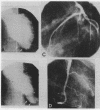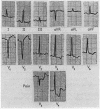Abstract
Three patients with thyrotoxicosis are described, in whom the presenting symptom was severe cardiac pain at rest or on effort and who were admitted to hospital with suspected or proven myocardial infarction. All patients were studied by selective coronary arteriography and left ventriculography after thyroid function tests which confirmed thyrotoxicosis. There was no demonstrable disease of the major coronary arteries in any of the patients, yet myocardial infarction and left ventricular aneurysm were shown to be present in 1, and there was definite electrocardiographic evidence of ischaemia in all 3. In addition, under stress the myocardium of all 3 patients produced lactate. It is recommended that thyrotoxicosis be seriously considered in the differential diagnosis of cardiac pain, particularly in younger women. The cause of the pain seems related to the cellular effects of thyrotoxicosis on the myocardium and current views of these effects are summarised. Of the 3 patients, 1 died suddenly 6 months after becoming euthyroid, indicating that the disease may not be as benign as expected. A guarded prognosis and continued medical follow-up are recommended when thyrotoxicosis presents with angina pectoris even when normal coronary arteries have been demonstrated.
Full text
PDF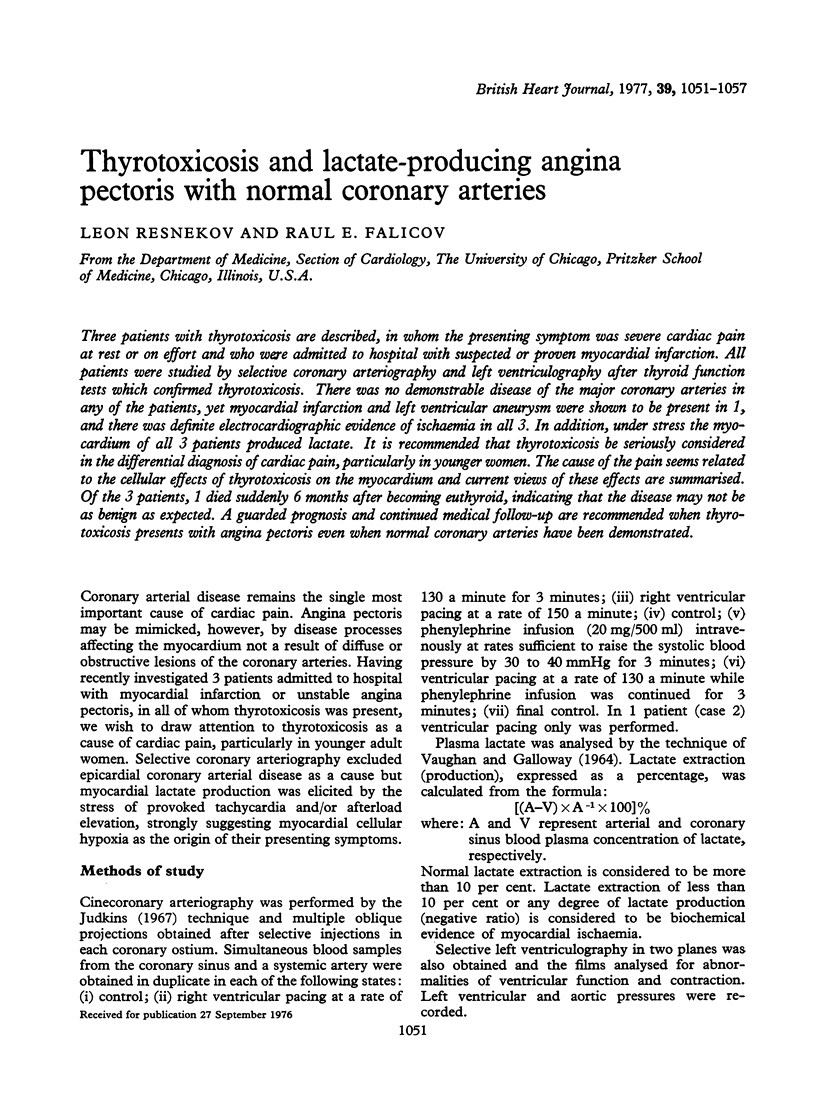
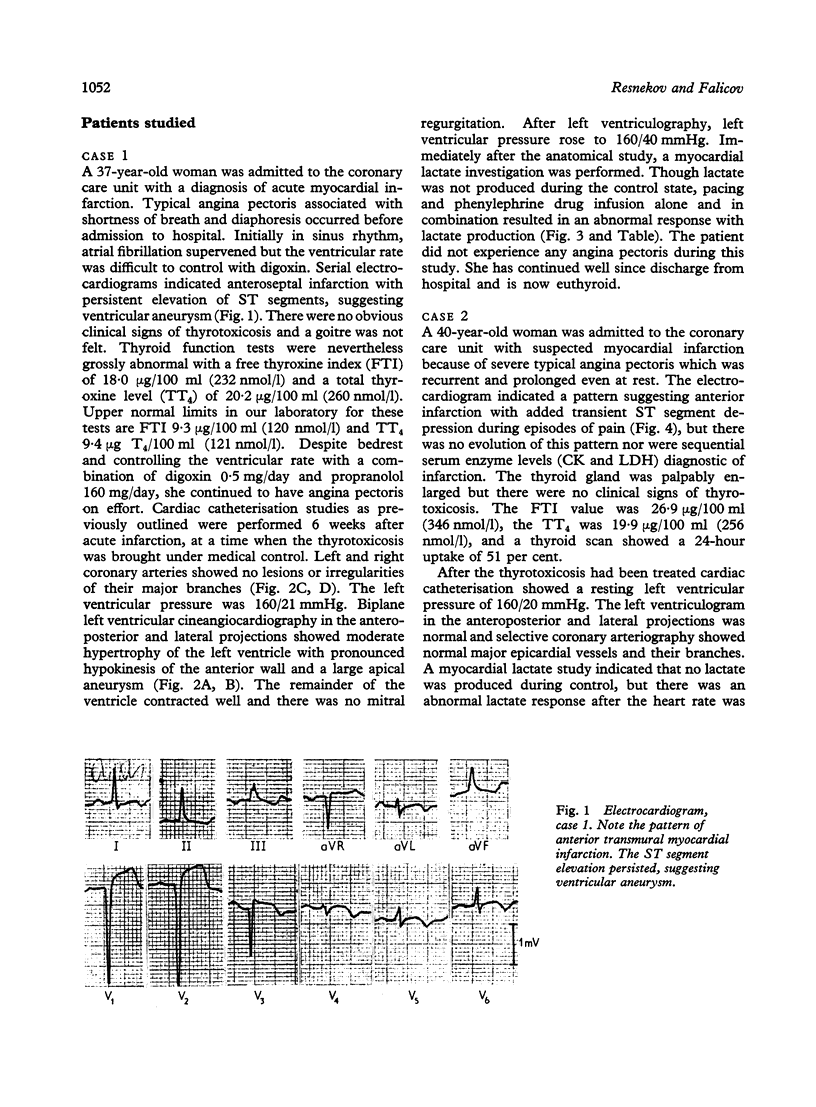
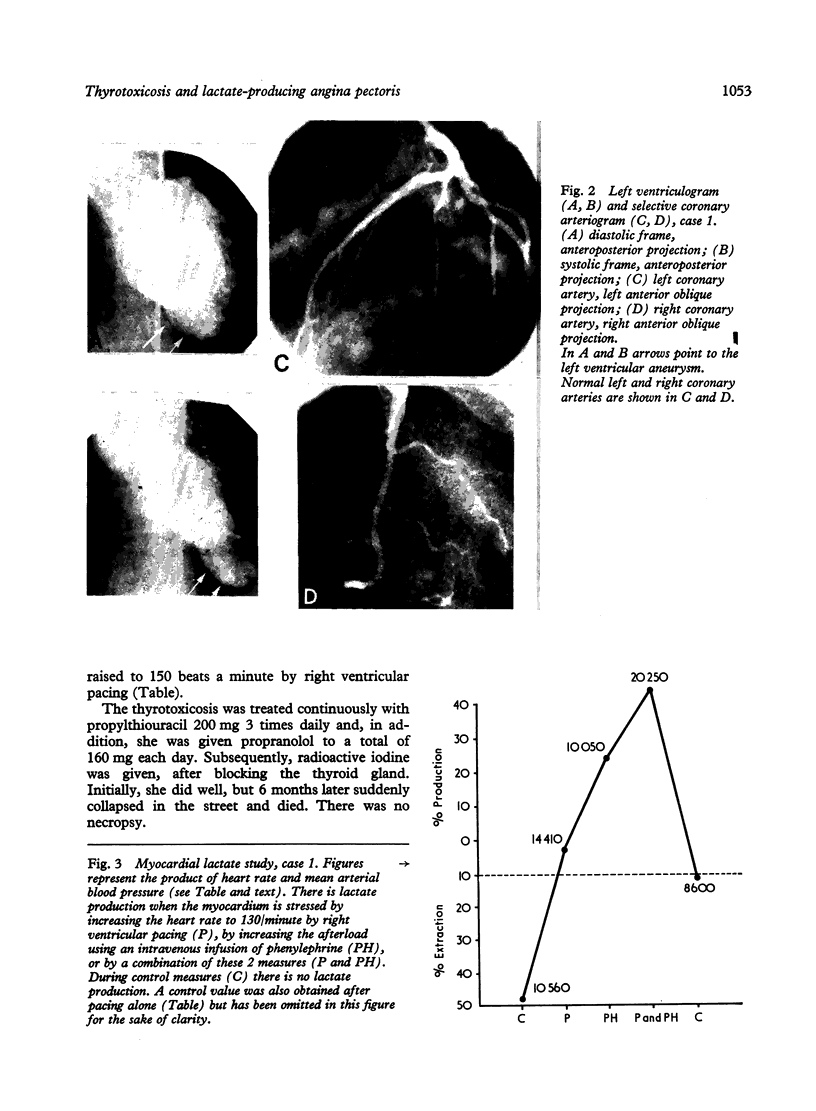
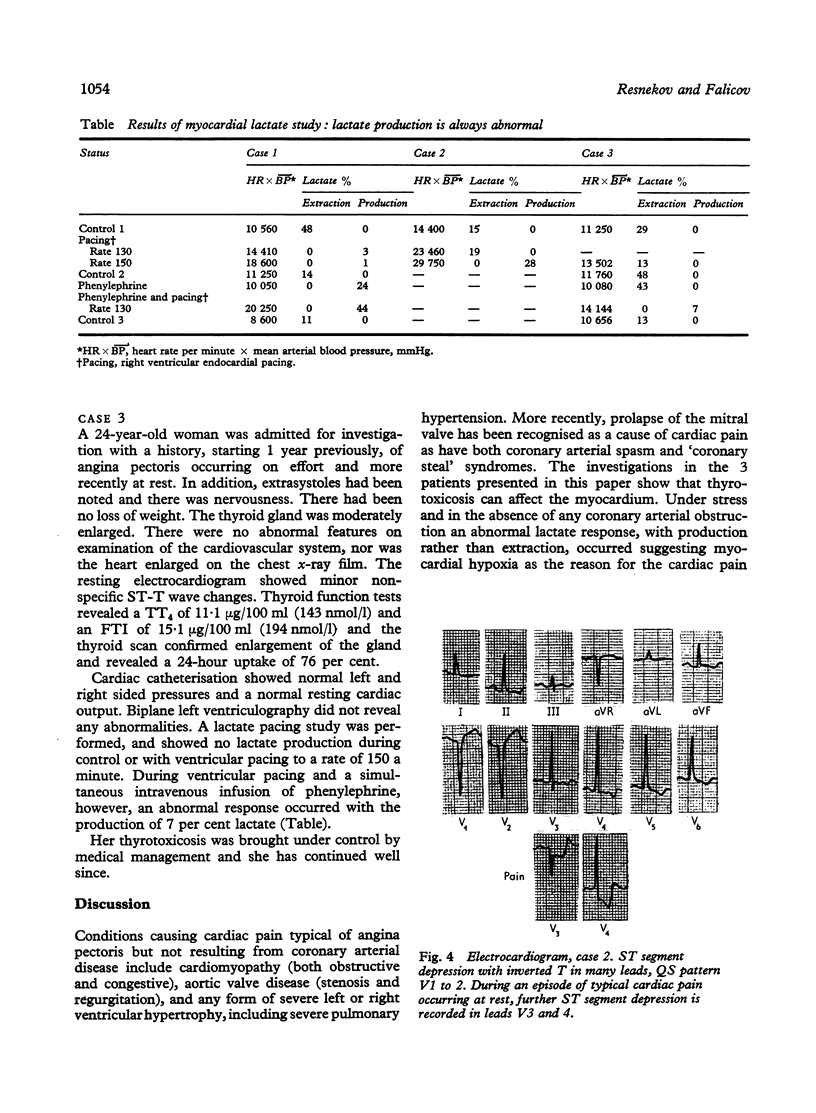
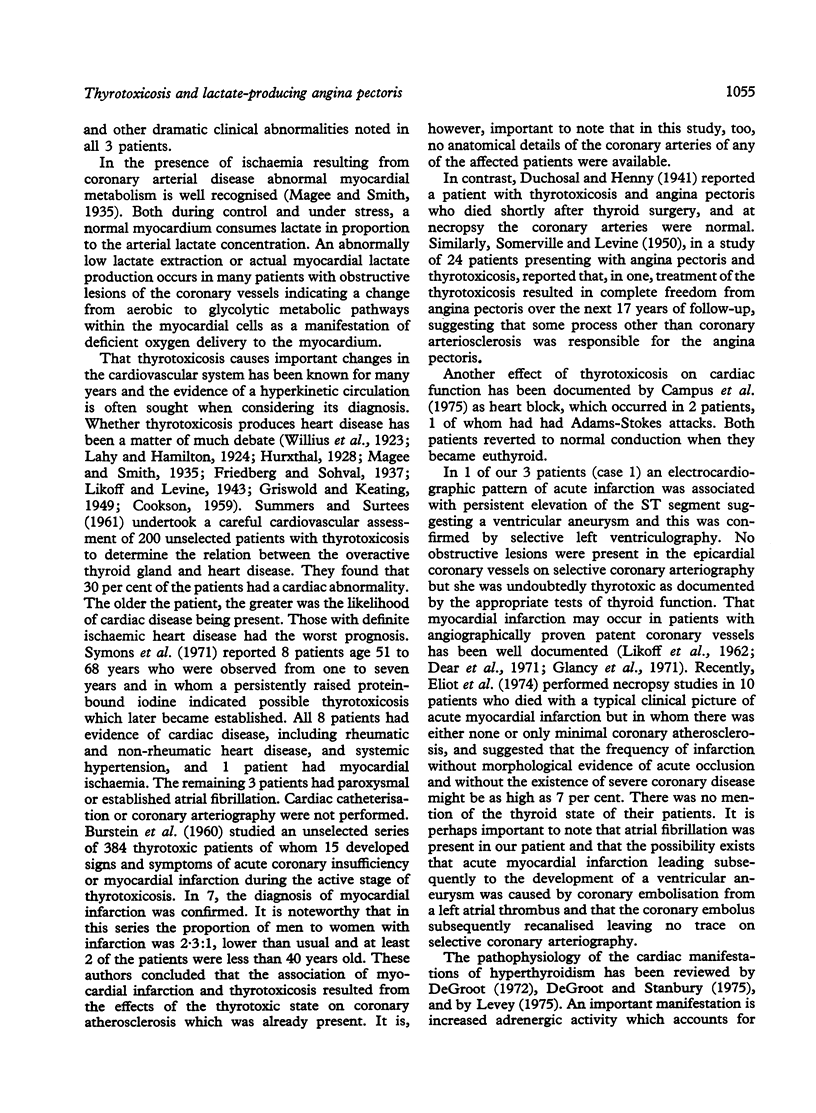
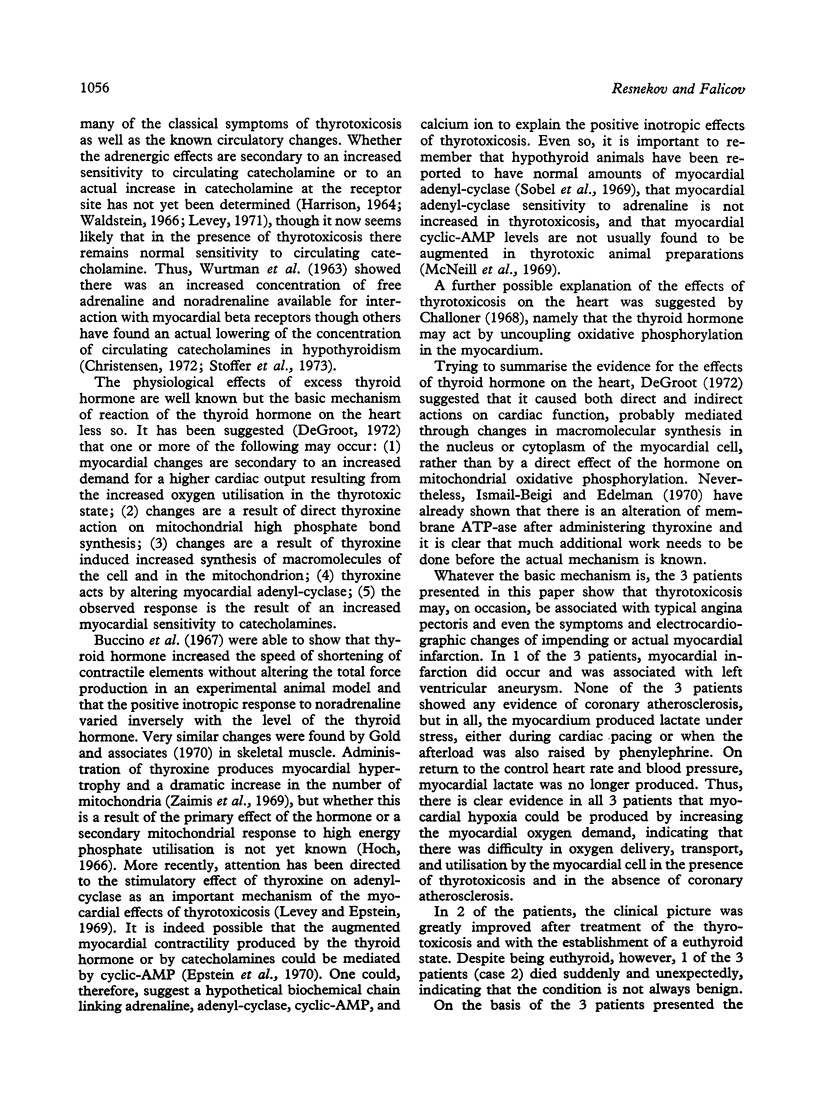
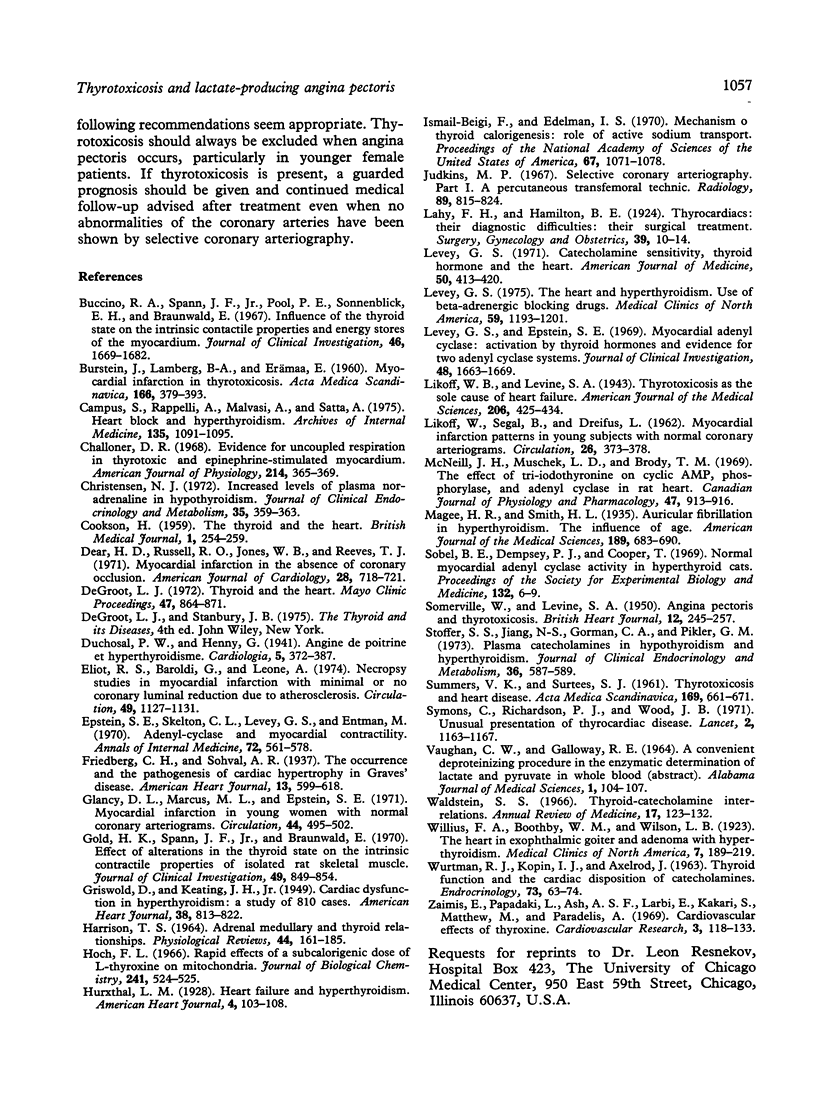
Images in this article
Selected References
These references are in PubMed. This may not be the complete list of references from this article.
- BURSTEIN J., LAMBERG B. A., ERAMAA E. Myocardial infarction in thyrotoxicosis. Acta Med Scand. 1960 Apr 20;166:379–393. doi: 10.1111/j.0954-6820.1960.tb17392.x. [DOI] [PubMed] [Google Scholar]
- Buccino R. A., Spann J. F., Jr, Pool P. E., Sonnenblick E. H., Braunwald E. Influence of the thyroid state on the intrinsic contractile properties and energy stores of the myocardium. J Clin Invest. 1967 Oct;46(10):1669–1682. doi: 10.1172/JCI105658. [DOI] [PMC free article] [PubMed] [Google Scholar]
- COOKSON H. The thyroid and the heart. Br Med J. 1959 Jan 31;1(5117):254–259. doi: 10.1136/bmj.1.5117.254. [DOI] [PMC free article] [PubMed] [Google Scholar]
- Campus S., Rappelli A., Malavasi A., Satta A. Heart block and hyperthyroidism. Report of two cases. Arch Intern Med. 1975 Aug;135(8):1091–1095. [PubMed] [Google Scholar]
- Challoner D. R. Evidence for uncoupled respiration in thyrotoxic and epinephrine-stimulated myocardium. Am J Physiol. 1968 Feb;214(2):365–369. doi: 10.1152/ajplegacy.1968.214.2.365. [DOI] [PubMed] [Google Scholar]
- DeGroot L. J. Thyroid and the heart. Mayo Clin Proc. 1972 Nov;47(11):864–871. [PubMed] [Google Scholar]
- Dear H. D., Russell R. O., Jones W. B., Reeves T. J. Myocardial infarction in the absence of coronary occlusion. Am J Cardiol. 1971 Dec;28(6):718–721. doi: 10.1016/0002-9149(71)90062-2. [DOI] [PubMed] [Google Scholar]
- Eliot R. S., Baroldi G., Leone A. Necropsy studies in myocardial infarction with minimal or no coronary luminal reduction due to atherosclerosis. Circulation. 1974 Jun;49(6):1127–1131. doi: 10.1161/01.cir.49.6.1127. [DOI] [PubMed] [Google Scholar]
- Epstein S. E., Skelton C. L., Levey G. S., Entman M. Adenyl cyclase and myocardial contractility. Ann Intern Med. 1970 Apr;72(4):561–578. doi: 10.7326/0003-4819-72-4-561. [DOI] [PubMed] [Google Scholar]
- GRISWOLD D., KEATING J. H., Jr Cardiac dysfunction in hyperthyroidism; a study of 810 cases. Am Heart J. 1949 Dec;38(6):813–822. doi: 10.1016/0002-8703(49)90883-2. [DOI] [PubMed] [Google Scholar]
- Glancy D. L., Marcus M. L., Epstein S. E. Myocardial infarction in young women with normal coronary arteriograms. Circulation. 1971 Oct;44(4):495–502. doi: 10.1161/01.cir.44.4.495. [DOI] [PubMed] [Google Scholar]
- Gold H. K., Spann J. F., Jr, Braunwald E. Effect of alterations in the thyroid state on the intrinsic contractile properties of isolated rat skeletal muscle. J Clin Invest. 1970 Apr;49(4):849–854. doi: 10.1172/JCI106298. [DOI] [PMC free article] [PubMed] [Google Scholar]
- HARRISON T. S. ADRENAL MEDULLARY AND THYROID RELATIONSHIPS. Physiol Rev. 1964 Apr;44:161–185. doi: 10.1152/physrev.1964.44.2.161. [DOI] [PubMed] [Google Scholar]
- Hoch F. L. Rapid effects of a subcalorigenic dose of L-thyroxine on mitochondria. J Biol Chem. 1966 Jan 25;241(2):524–525. [PubMed] [Google Scholar]
- Izmail-Beigi F., Edelman I. S. Mechanism of thyroid calorigenesis: role of active sodium transport. Proc Natl Acad Sci U S A. 1970 Oct;67(2):1071–1078. doi: 10.1073/pnas.67.2.1071. [DOI] [PMC free article] [PubMed] [Google Scholar]
- Judkins M. P. Selective coronary arteriography. I. A percutaneous transfemoral technic. Radiology. 1967 Nov;89(5):815–824. doi: 10.1148/89.5.815. [DOI] [PubMed] [Google Scholar]
- LIKOFF W., SEGAL B., DREIFUS L. Myocardial infarction patterns in young subjects with normal coronary arteriograns. Circulation. 1962 Sep;26:373–378. doi: 10.1161/01.cir.26.3.373. [DOI] [PubMed] [Google Scholar]
- Levey G. S., Epstein S. E. Myocardial adenyl cyclase: activation by thyroid hormones and evidence for two adenyl cyclase systems. J Clin Invest. 1969 Sep;48(9):1663–1669. doi: 10.1172/JCI106131. [DOI] [PMC free article] [PubMed] [Google Scholar]
- Levey G. S. The heart and hyperthyroidism. Use of beta-adrenergic blocking drugs. Med Clin North Am. 1975 Sep;59(5):1193–1199. doi: 10.1016/s0025-7125(16)31967-8. [DOI] [PubMed] [Google Scholar]
- McNeill J. H., Muschek L. D., Brody T. M. The effect of triiodothyronine on cyclic AMP, phosphorylase, and adenyl cyclase in rat heart. Can J Physiol Pharmacol. 1969 Nov;47(11):913–916. doi: 10.1139/y69-149. [DOI] [PubMed] [Google Scholar]
- SOMERVILLE W., LEVINE S. A. Angina pectoris and thyrotoxicosis. Br Heart J. 1950 Jul;12(3):245–257. doi: 10.1136/hrt.12.3.245. [DOI] [PMC free article] [PubMed] [Google Scholar]
- Stoffer S. S., Jiang N. S., Gorman C. A., Pikler G. M. Plasma catecholamines in hypothyroidism and hyperthyroidism. J Clin Endocrinol Metab. 1973 Mar;36(3):587–589. doi: 10.1210/jcem-36-3-587. [DOI] [PubMed] [Google Scholar]
- Symons C., Richardson P. J., Wood J. B. Unusual presentation of thyrocardiac disease. Lancet. 1971 Nov 27;2(7735):1163–1167. doi: 10.1016/s0140-6736(71)90485-5. [DOI] [PubMed] [Google Scholar]
- VAUGHAN C. W., GALLOWAY R. E. A CONVENIENT DEPROTEINIZING PROCEDURE IN THE ENZYMATIC DETERMINATION OF LACTATE AND PYRUVATE IN WHOLE BLOOD. Ala J Med Sci. 1964 Jan;1:104–107. [PubMed] [Google Scholar]
- WURTMAN R. J., KOPIN I. J., AXELROD J. Thyroid function and the cardiac disposition of catecholamines. Endocrinology. 1963 Jul;73:63–74. doi: 10.1210/endo-73-1-63. [DOI] [PubMed] [Google Scholar]
- Waldstein S. S. Thyroid-catecholamine interrelations. Annu Rev Med. 1966;17:123–132. doi: 10.1146/annurev.me.17.020166.001011. [DOI] [PubMed] [Google Scholar]
- Zaimis E., Papadaki L., Ash A. S., Larbi E., Kakari S., Matthew M., Paradelis A. Cardiovascular effects of thyroxine. Cardiovasc Res. 1969 Apr;3(2):118–133. doi: 10.1093/cvr/3.2.118. [DOI] [PubMed] [Google Scholar]




